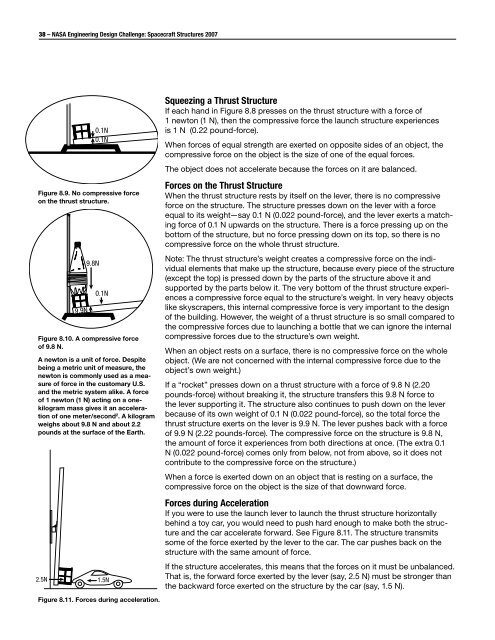Spacecraft Structures pdf - ER - NASA
Spacecraft Structures pdf - ER - NASA
Spacecraft Structures pdf - ER - NASA
- No tags were found...
You also want an ePaper? Increase the reach of your titles
YUMPU automatically turns print PDFs into web optimized ePapers that Google loves.
38 – <strong>NASA</strong> Engineering Design Challenge: <strong>Spacecraft</strong> <strong>Structures</strong> 20070.1N0.1NFigure 8.9. No compressive forceon the thrust structure.9.9N9.8N0.1NFigure 8.10. A compressive forceof 9.8 N.A newton is a unit of force. Despitebeing a metric unit of measure, thenewton is commonly used as a measureof force in the customary U.S.and the metric system alike. A forceof 1 newton (1 N) acting on a onekilogrammass gives it an accelerationof one meter/second 2 . A kilogramweighs about 9.8 N and about 2.2pounds at the surface of the Earth.2.5N 1.5NFigure 8.11. Forces during acceleration.Squeezing a Thrust StructureIf each hand in Figure 8.8 presses on the thrust structure with a force of1 newton (1 N), then the compressive force the launch structure experiencesis 1 N (0.22 pound-force).When forces of equal strength are exerted on opposite sides of an object, thecompressive force on the object is the size of one of the equal forces.The object does not accelerate because the forces on it are balanced.Forces on the Thrust StructureWhen the thrust structure rests by itself on the lever, there is no compressiveforce on the structure. The structure presses down on the lever with a forceequal to its weight—say 0.1 N (0.022 pound-force), and the lever exerts a matchingforce of 0.1 N upwards on the structure. There is a force pressing up on thebottom of the structure, but no force pressing down on its top, so there is nocompressive force on the whole thrust structure.Note: The thrust structure’s weight creates a compressive force on the individualelements that make up the structure, because every piece of the structure(except the top) is pressed down by the parts of the structure above it andsupported by the parts below it. The very bottom of the thrust structure experiencesa compressive force equal to the structure’s weight. In very heavy objectslike skyscrapers, this internal compressive force is very important to the designof the building. However, the weight of a thrust structure is so small compared tothe compressive forces due to launching a bottle that we can ignore the internalcompressive forces due to the structure’s own weight.When an object rests on a surface, there is no compressive force on the wholeobject. (We are not concerned with the internal compressive force due to theobject’s own weight.)If a “rocket” presses down on a thrust structure with a force of 9.8 N (2.20pounds-force) without breaking it, the structure transfers this 9.8 N force tothe lever supporting it. The structure also continues to push down on the leverbecause of its own weight of 0.1 N (0.022 pound-force), so the total force thethrust structure exerts on the lever is 9.9 N. The lever pushes back with a forceof 9.9 N (2.22 pounds-force). The compressive force on the structure is 9.8 N,the amount of force it experiences from both directions at once. (The extra 0.1N (0.022 pound-force) comes only from below, not from above, so it does notcontribute to the compressive force on the structure.)When a force is exerted down on an object that is resting on a surface, thecompressive force on the object is the size of that downward force.Forces during AccelerationIf you were to use the launch lever to launch the thrust structure horizontallybehind a toy car, you would need to push hard enough to make both the structureand the car accelerate forward. See Figure 8.11. The structure transmitssome of the force exerted by the lever to the car. The car pushes back on thestructure with the same amount of force.If the structure accelerates, this means that the forces on it must be unbalanced.That is, the forward force exerted by the lever (say, 2.5 N) must be stronger thanthe backward force exerted on the structure by the car (say, 1.5 N).
















